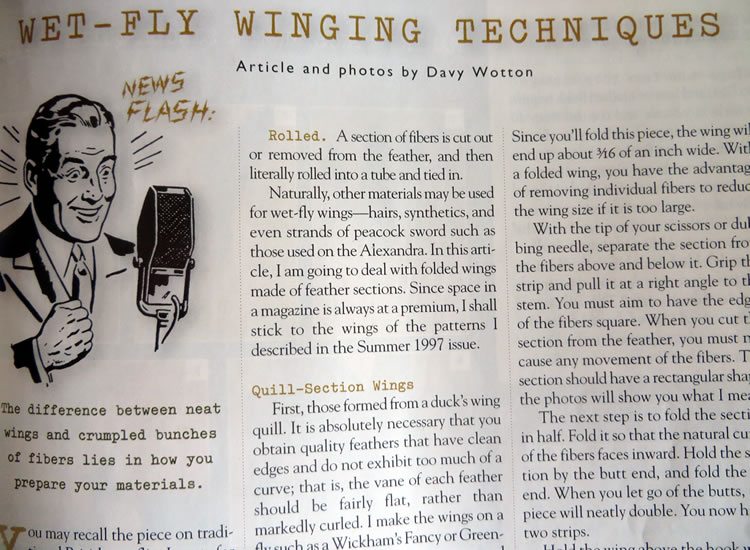I guess for all of us there must be a fish, regardless of species, or size that will remain as a memory so long as you live. For some of you it may have been the first fish that you caught, it may have been a specimen of a given species, it may have been a fish that you saw another person catch, or it may have been a fish that pulled every bit of knowledge and skill from you before you hooked it.
For my self there are two particular fish that l will never forget, and for two very different reasons. Sometimes you may only have one opportunity to get it right, other times you may be in a position to return on many occasions to pit your wits against the adversary. So l would like to tell you my two stories.
The first took place in Chile. That all started when my friend Marcus and myself took a group of clients to fish in Coyaquie southern Chile. On one of the days l had with me Carlos Vergara a noted photographer from Chicago. Our day started with a typical drift boat scenario down the Rio Baker river system, along the down stream drift catching plenty of fat Browns and rainbows.
As we came to a wide angled bend in the river l noticed a very big bow tucked up against the shore line in the back eddy facing in a direction other than the natural flow of the river. There was no way this fish could be approached with the boat. I requested John to pull the boat to the shoreline to allow me to get out and see if there was a way l could get closer to this fish.
That he did and on closer investigation, walking around that bay of the back eddy, very quickly established that it could not be done due to shoreline vegetation and rock structure. There was only one possible position to be able to see the fish and secondly a remote possibility that l could get the fly to that fish. I will try to explain if l can the situation that existed .
The only point that l could see the fish was from a high bank of something like 20 ft above the water. This big bay was off the main steam of current and the fish was positioned to my left along the rock wall shoreline at least 80 ft from my position looking out to the main body of the river. There was no chance at all from a lower level if l climbed down to be able to reach that far as l had no room for a back cast of any kind, and a roll cast at that range was totally out of the question also. Yet I was not going to be defeated as yet by that fish.
A number of times over the years l had cast to fish from high points above the water surface and hooked and landed many fine trout. Two factors come into play here so far as the cast was concerned. The first was the actual distance of the fish, the second was the amount of additional line required to allow for the elevation that l was at. Ok, I pretty much new that the whole fly line and a bit more would be needed to pull this one off.
Off came my jacket which was placed on the grass, that to avoid my fly line getting caught up during the cast. A hares ear nymph was attached to the tippet. My leader length was increased, line was stripped off on to the jacket and l was ready to go. All of which was photographed by Carlos.
The line was worked out the length l needed to be able to shoot the remaining line and backing. Away it went, and it seemed an eternity before it all became subjected to the force of gravity. Right on target within a few feet, enough for the rainbow to move forward and take the fly, and she was hooked.
The next problem was to be able to get down the bank to a low level and be able to release the fish. That took two of us. First l had to climb down and have my rod handed to me. All was well, she was still connected. Before too long this great beauty of a rainbow around 6lb slid slowly on her side toward me for her release back into her watery world. I will never forget that fish, and thanks to Carlos l have a photographic memory of that time.
My second fond memory of a fish was back in Wales on the river USK. This river was a short distance from my home and one l fished very often for both Atlantic salmon and the indigenous Brown trout that also are found in this river. This particular river has its name engraved in fly fishing history as many of the then notables of the past ventured to fish this natural wild water, which at one time contained countless 1000s of salmon and trout.
It is even known that the Romans who settled in this part of the world some few 1000 years ago took fishes from this river, in fact the very name comes from a Roman word. Like many other rivers today sadly the numbers of anadromous fish species have declined dramatically and that is certainly the case so far as the salmon is concerned. So too the Brown trout population has dwindled, not from the effects of overfishing, but from the other unfortunate influences of man, such as water abstraction, the filtration of agricultural chemicals and so on.
I would have loved to have fished that river back in the 1800s. Such river systems that contain relatively small numbers of trout are hard to fish and l know many persons who fished that river gave up on it for that very reason. So too the Brown trout is a creature of habit and you have to be on their terms to be able to catch them consistently. They are a different breed than the rainbow. Many times l would fish that river and not catch a fish and l knew a great deal of that water like the back of my hand. I knew how those fish would move up and down the water as the season changed and the food sources changed, from mayfly to caddis and whatever else was important to the diet of those fish at the time.
I never did catch a fish over 5lb in weight and l caught many 100s over the years in this river, but one particular fish l will never forget. One of the most important of fly fishing skills is your power of observation and not to be deceived by what your eyes see and how your brain sees.
Often l would sit and scan a zone of water watching for fish that would cruise around as they do on patrol looking for food. In may cases here it could be stonefly nymph, caddis larva or some of the mayfly and baetis nymphs that were abundant. A brown trout will root around and disturb rocks to find food this way and l have seen them go through the act of dislodging caddis larva that have fastened in their cases to rocks prior to pupation.
On this day a big brown came into view in the shallows, moving back and forth to a fast water run close to a number of big rocks. At that position l could not see the fish but was pretty sure l knew his place. My problem was to be able to get a cast to that position without the fish becoming aware of my presence, if he did he would be way down the river like a shot. There are times that you had better think hard before you rush into that act of fishing, this was certainly one of those times.
I knew that the presence of dusk and darkness would allow me to get closer to that fish, but l also knew that he would not likely hold there at that time, he would go on his patrol looking for food. Therefore l had to have a plan of action. I knew well enough what l needed to catch that fish so far as the fly was concerned, and there would have been a number l could have used to do that.
If you take the time to watch a individual fish he will normally have some kind of routine, and a zone that he likes to move around in, his territory if you like, such is the way of a Brown trout. They will in the early season be hungry and move around a great deal in the day time period, as food becomes more abundant and more active during diminished light conditions so his feeding patterns will change.
Brown trout have a very keen sight and a sense of smell, and l have seen them many times refuse a fly because of those senses. I figured out that l would have to lay in ambush to catch this worthy quarry. Many times l went to the river to look for this fish and many times l did not see him but as many l did. I could map out his chosen route.
My first method of approach was to find the position that l could cast without being seen, l had only two choices for that, one of which was not ideal the other was ok but it would restrict me with what l could use so far as the fly was concerned, that was what l thought at the time. I do not recall how may times l did fish from that position but sufficeit to say on one of those days the trout began to cruise around.
Gold rib hares ear nymph was one of my top 10 for fishing this river and so it was that this small fly was cast in a way to intercept this fish, he took it first time he saw it, took off down stream and he was lost with the fly, oh well l did catch him. Now l know that a Brown that is caught very close to his safe lie may never return to it, but if he was hooked and lost some way from it he will likely return to it. And this was the case with this fish.
A Brown trout also does appear to have some kind of memory bank for bad things that have happened to him and to catch the same fish again l know would take some doing. At that time the caddis were becoming active, both the stages of larva forming cases on the rocks and the emergence of the adults in the dusk to dark period. This can of course be a golden time to hook a good Brown trout. So it was that l walked to river bank path to the fishes location.
Knowing that this fish was in this zone my approach was a cautious one, and there before my eyes was the trout foraging around over the shallow gravel and small rocky structure to my side of the bank, which was the position that became my 2nd choice.
I knew what he was doing, and in consequence of that rigged up with a caddis larva, a cream bodied fly with a dark ostrich herl head. I frequently fish with long leaders way more than 9 ft and this was certainly the case for that too. I waited until the fish was way above me, which gave me enough time to first get down to a low position, and second to be able to set that fly out over the gravel. In fact it laid there static, that was the tactic.
A number of times he came to the zone but not close enough, eventually he did as he neared my fly l gave it a fraction of a twitch and he took it good and felt the sting of the hook. This time he was mine, a fish of about 16 inches. The hares ear nymph was gone from the previous encounter. Good luck my dear friend as he was released again, this time from my hands and not the hook that he took with him.
I have had many encounters over the years when more than the act of fishing was part of the game to hook a fish, most of those over a short period of time, in this fish it was very many weeks. A fish l will never forget.


